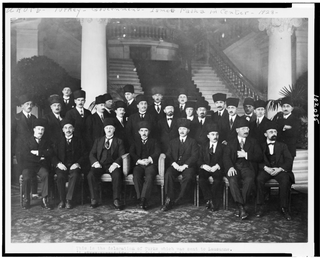
The International Court of Justice, or colloquially the World Court, is the only international court that adjudicates general disputes between nations, and gives advisory opinions on international legal issues. It is one of the six organs of the United Nations (UN), and is located in The Hague, Netherlands.

The Permanent Court of International Justice, often called the World Court, existed from 1922 to 1946. It was an international court attached to the League of Nations. Created in 1920, the court was initially well-received from states and academics alike, with many cases submitted to it for its first decade of operation.

The Conference of Lausanne was a conference held in Lausanne, Switzerland, during 1922 and 1923. Its purpose was the negotiation of a treaty to replace the Treaty of Sèvres, which, under the new government of Mustafa Kemal Atatürk, was no longer recognized by Turkey.

The United Nations Commission on International Trade Law (UNCITRAL) is a subsidiary body of the U.N. General Assembly (UNGA) responsible for helping to facilitate international trade and investment.

The Convention on the Recognition and Enforcement of Foreign Arbitral Awards, commonly known as the New York Convention, was adopted by a United Nations diplomatic conference on 10 June 1958 and entered into force on 7 June 1959. The Convention requires courts of contracting states to give effect to private agreements to arbitrate and to recognize and enforce arbitration awards made in other contracting states. Widely considered the foundational instrument for international arbitration, it applies to arbitrations that are not considered as domestic awards in the state where recognition and enforcement is sought.
The International Court of Justice has jurisdiction in two types of cases: contentious cases between states in which the court produces binding rulings between states that agree, or have previously agreed, to submit to the ruling of the court; and advisory opinions, which provide reasoned, but non-binding, rulings on properly submitted questions of international law, usually at the request of the United Nations General Assembly. Advisory opinions do not have to concern particular controversies between states, though they often do.

The 1923 population exchange between Greece and Turkey stemmed from the "Convention Concerning the Exchange of Greek and Turkish Populations" signed at Lausanne, Switzerland, on 30 January 1923, by the governments of Greece and Turkey. It involved at least 1.6 million people, most of whom were forcibly made refugees and de jure denaturalized from their homelands.
International arbitration is arbitration between companies or individuals in different states, usually by including a provision for future disputes in a contract.

Wilsonian Armenia was the unimplemented boundary configuration of the First Republic of Armenia in the Treaty of Sèvres, as drawn by U.S. President Woodrow Wilson's Department of State. The Treaty of Sèvres was a peace treaty that had been drafted and signed between the Western Allied Powers and the defeated government of the Ottoman Empire in August 1920, but it was never ratified and was subsequently superseded by the Treaty of Lausanne. The proposed boundaries of Wilsonian Armenia incorporated portions of the Ottoman vilayets of Erzurum, Bitlis, Van, and Trabzon, which had Armenian populations of varying sizes. The inclusion of portions of Trabzon Vilayet was intended to provide the First Republic of Armenia with an outlet to the Black Sea at the port of Trabzon. A proposed Republic of Pontus was discussed at the Paris Peace Conference of 1919, but the Greek government of Eleftherios Venizelos feared the precarious position of such a state, so a portion of it was instead included in the proposed state of Wilsonian Armenia.

Stephen Myron Schwebel, is an American jurist and international judge, counsel and arbitrator. He previously served as judge of the World Bank Administrative Tribunal (2010–2017), as a member of the U.S. National Group at the Permanent Court of Arbitration, as president of the International Monetary Fund Administrative Tribunal (1993–2010), as president of the International Court of Justice (1997–2000), as vice president of the International Court of Justice (1994–1997), and as Judge of the International Court of Justice (1981–2000). Prior to his tenure on the ICJ, Schwebel served as deputy legal adviser to the U.S. Department of State (1974–1981) and as assistant legal adviser to the U.S. Department of State (1961–1967). He also served as a professor of law at Harvard Law School (1959–1961) and Johns Hopkins University (1967–1981). Schwebel is noted for his expansive opinions in momentous cases such as Legality of the Threat or Use of Nuclear Weapons, Military and Paramilitary Activities in and Against Nicaragua and Oil Platforms .

Arbitration is a formal method of dispute resolution involving a third party neutral who makes a binding decision. The third party neutral renders the decision in the form of an 'arbitration award'. An arbitration award is legally binding on both sides and enforceable in local courts, unless all parties stipulate that the arbitration process and decision are non-binding.

The partition of the Ottoman Empire was a geopolitical event that occurred after World War I and the occupation of Constantinople by British, French, and Italian troops in November 1918. The partitioning was planned in several agreements made by the Allied Powers early in the course of World War I, notably the Sykes–Picot Agreement, after the Ottoman Empire had joined Germany to form the Ottoman–German alliance. The huge conglomeration of territories and peoples that formerly comprised the Ottoman Empire was divided into several new states. The Ottoman Empire had been the leading Islamic state in geopolitical, cultural, and ideological terms. The partitioning of the Ottoman Empire after the war led to the domination of the Middle East by Western powers such as Britain and France, and saw the creation of the modern Arab world and the Republic of Turkey. Resistance to the influence of these powers came from the Turkish National Movement but did not become widespread in the other post-Ottoman states until the period of rapid decolonization after World War II.
The Tarlis incident was the killing of 17 ethnically Bulgarian peasants by a Greek officer on July 27, 1924, at Tarlis, a mountainous village in the Kato Nevrokopi region near the Greco-Bulgarian border.
Albert Jan van den Berg is a founding partner of Hanotiau & van den Berg in Brussels, an emeritus Professor of Law at the Erasmus University, Rotterdam, a visiting professor at Georgetown University Law Center, Washington DC and at the University of TsinghuaArchived 2018-08-10 at the Wayback Machine School of Law, Beijing and a member of the advisory board and Faculty of the Geneva Master of Laws in International Dispute Settlement (MIDS), Geneva.
The Convention Concerning the Exchange of Greek and Turkish Populations, also known as the Lausanne Convention, was an agreement between the Greek and Turkish governments signed by their representatives in Lausanne on 30 January 1923, in the aftermath of the Greco-Turkish War of 1919–1922. The agreement provided for the simultaneous expulsion of Orthodox Christians from Turkey to Greece and of Muslims from Greece to Turkey. These involuntary population transfers involved approximately two million people, around 1.5 million Anatolian Greeks and 500,000 Muslims in Greece.
ZF Automotive U. S., Inc. v. Luxshare, Ltd., 596 U.S. ___ (2022), is a decision of the United States Supreme Court on the scope of §1782 of Title 28 of the United States Code. The issue of statutory interpretation for the Court was whether a private commercial arbitral tribunal constitutes a "foreign or international tribunal" under 28 U.S.C. § 1782(a) and therefore empowers federal districts courts to compel the production by persons subject to their jurisdiction of documents and testimony for such tribunals.

The Paris Arbitral Award is an arbitral award issued on 3 October 1899 by an arbitral tribunal convened in Paris, created two years earlier as established in the Arbitral Treaty of Washington D. C. on 2 February 1897, in which the United States on the one hand and the United Kingdom on the other, had agreed to submit to international arbitration the dispute over the border to the west of the British colony and the east of independent Venezuela, as a mechanism for an amicable solution to the territorial differendum.
The Mixed Commission for the Exchange of Greek and Turkish Populations was an international body established under the 1923 Treaty of Lausanne to oversee the compulsory population exchange between Greece and Turkey following World War I. The commission was responsible for managing the logistics, resolving disputes, and ensuring the implementation of the exchange's terms, which involved the relocation of over 1.5 million people based on their religious identity.
The Greco-Turkish Mixed Arbitral Tribunal was an international judicial body established under the Greco-Turkish Agreement of December 1, 1926, to resolve legal disputes arising from the compulsory population exchange between Greece and Turkey. It operated under the supervision of the League of Nations and played a crucial role in addressing conflicts related to property restitution, compensation claims, and jurisdictional disagreements stemming from the exchange.
Article IV of the Final Protocol refers to a key provision of the Greco-Turkish Agreement of December 1, 1926, which outlined procedures for resolving disputes arising from the compulsory population exchange between Greece and Turkey. The article established the framework for referring unresolved disagreements to arbitration, a mechanism critical for addressing the complex legal and logistical challenges resulting from the exchange.